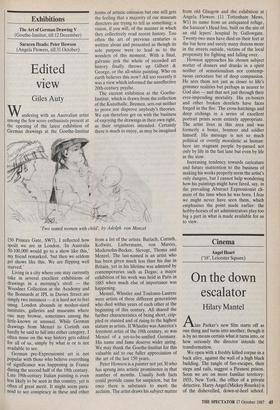Exhibitions
The Art of German Drawing V (Goethe-Institut, till 12 December) Saracen Heads: Peter Howson (Angela Flowers, till 31 October)
Edited view
Giles Auty
Wandering with an Australian artist among the few score enthusiasts present at the opening of the latest exhibition of German drawings at the Goethe-Institut 'Two seated women with child', by Adolph von Menzel (50 Princes Gate, SW7), I reflected how spoilt we are in London. 'In Australia 50-100,000 would go to a show like this,' my friend remarked, tut then we seldom get shows like this. We are flipping well starved.'
Living in a city where one may currently take in several excellent exhibitions of drawings in a morning's stroll — the Woodner Collection at the Academy and the Bonnards at JPL in Davies Street are simply two instances — it is hard not to feel smug. London abounds in modest-sized institutes, galleries and museums where one may browse, sometimes among the little-known or unusual. While German drawings from Menzel to Corinth can hardly be said to fall into either category, I often muse on the way history gets edited for all of us, simply by what is or is not available to see.
German pre-Expressionist art is not Popular with those who believe everything of significance was happening in France during the second half of the 19th century. Late 19th-century Italian painting is even less likely to be seen in this country, yet is often of great merit. It might seem para- noid to see conspiracy in these and other forms of artistic oinission but one still gets the feeling that a majority of our museum directors are trying to tell us something; a vision, if you will, of the manner in which they collectively read recent history. Too often the art of previous centuries is written about and presented as though its sole purpose were to lead us to the wonders of this moment. With a final, galvanic jerk the whole of recorded art history finally throws up Gilbert & George, or the all-white painting. Who on earth believes this now? All too recently it was a view which informed the unreflective 20th-century psyche.
The current exhibition at the Goethe- Institut, which is drawn from the collection of the Kunsthalle, Bremen, sets out neither to prove nor disprove anybody's theories. We can therefore get on with the business of enjoying the drawings in their own right, as their originators intended. Certainly there is much to enjoy, as may be imagined from a list of the artists: Barlach, Corinth, Kollwitz, Liebermann, von Marees, Modersohn-Becker, Slevogt, Thoma and Menzel. The last-named is an artist who has been given much less than his due in Britain, yet in his lifetime was admired by contemporaries such as Degas; a major exhibition of his work was held in Paris in 1885 when much else of importance was happening.
Menzel, Whistler and Toulouse-Lautrec were artists of three different generations who died within years of each other at the beginning of this century. All shared the further characteristics of being short, crip- pled or stunted and of rising to the highest stature as artists. If Whistler was America's foremost artist of the 19th century, so was Menzel of a yet-to-be-unified Germany. His name and fame deserve wider airing. We may thank the Goethe-Institut for this valuable aid to our fuller appreciation of the art of the last 150 years.
Peter Howson is a painter not yet 30 who has sprung into artistic prominence in that number of months. Usually both facts could provide cause for suspicion, but for once there is substance to merit the acclaim. The artist draws his subject matter from old Glasgow and the exhibition at Angela Flowers (11 Tottenham Mews, W1) its name from an antiquated refuge, the Saracen's Head Inn, built on the site of an old lepers' hospital by Gallowgate. Twenty-two men have died on their feet at the bar here and surely many dozens more in the streets outside, victims of the local propensity for fighting and falling over.
Howson approaches his chosen subject matter of dossers and drunks in a spirit neither of sensationalism nor contemp- tuous caricature but of deep compassion. He sees them not just as closer to life's grimmer realities but perhaps as nearer to God also — and that not just through their ever-impending mortality. His ex-boxers and other broken derelicts have faces forged in the fire. The cross-hatchings and deep etchings in a series of excellent portrait prints seem entirely appropriate. The artist lives in this area and was formerly a boxer, bouncer and soldier himself. His message is not so much political or overtly moralistic as human: here are stagnant people by-passed not only by life in the fast lane but even by life in the slow.
Increasing tendency towards caricature and future inattention to the business of making his works properly seem the artist's only dangers, but I cannot help wondering how his paintings might have fared, say, in the prevailing Abstract Expressionist cli- mate of the time when he was born. I fear we might never have seen them, which emphasises the point made earlier: the hobby-horses of art administrators play too big a part in what is made available for us to view.


























































 Previous page
Previous page